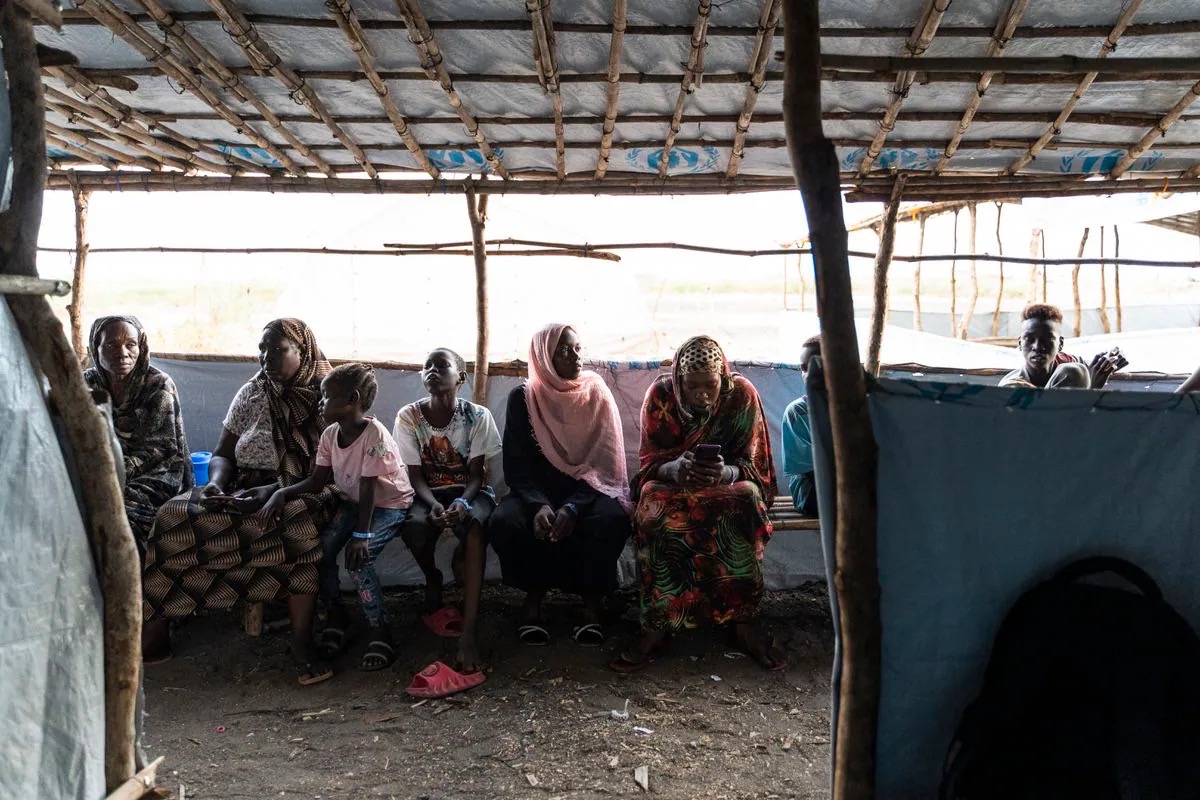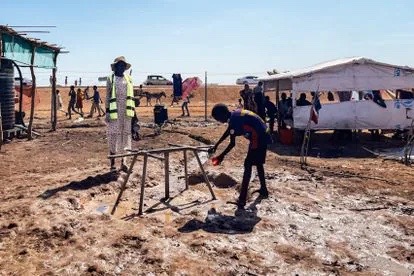Analysis from UN OCHA
Dated Thursday, 7 December 2023 - here is a copy in full:
SUDAN Humanitarian Update 7 December 2023
HIGHLIGHTS
- 6.6 million people have been displaced inside and outside Sudan since fighting broke out between the Sudanese Armed Forces and the Rapid Support Forces.
- More than 12,190 people have been killed since the fighting broke out in mid-April.
- Eighty children have been identified among the people detained by Rapid Support Forces in Ardamata, West Darfur State.
- The number of suspected cholera cases has more than doubled over the past month reaching 5,414 cases, including 170 associated deaths.
- Insecurity, looting, bureaucratic impediments, poor network and phone connectivity, lack of cash, and limited technical and humanitarian staff on the ground have affected the delivery of humanitarian aid in many parts of the country.
- The revised 2023 Sudan Humanitarian Response Plan appeal is only 38.6 per cent funded as of 7 December.
[SW Ed: to view a larger version visit the original and copy & paste the map] Sudan Humanitarian Update (7 December 2023)
SITUATION OVERVIEW
Since fighting between the Sudanese Armed Forces (SAF) and the Rapid Support Forces (RSF) erupted in mid-April, an estimated 6.6 million people have fled their homes, taking refuge inside and outside the country, with children representing about half of the people displaced. Sudan is now the country with the largest number of displaced people and the largest child displacement crisis in the world. ACLED estimates that more than 12,190 people have been killed since the fighting broke out in April, including 1,300 people who were killed between 28 October and 24 November. Compared to the previous four weeks, ACLED recorded a 10 per cent decrease in battles and a 38 per cent decrease in explosions and remote violence in Sudan.
According to the International Organization for Migration Displacement Tracking Matrix (IOM DTM) Sudan Monthly Displacement Overview (03), about 5.3 million people have been displaced within Sudan. People have been displaced in 5,473 locations across the country’s 18 states, an increase of 161 locations in one week. Overall, 47 per cent of the displaced people have sought refuge across the Darfur and Kordofan regions, whereas the majority (53 per cent) of the displaced people have been observed in the northern, eastern, and central states. Most of the people displaced, about 3.4 million (64.7 per cent of displaced), are from Khartoum and have sought shelter in River Nile, Aj Jazirah, White Nile, East Darfur, and Northern states. Most displaced people (64 per cent) live with host communities, while 12.7 per cent have taken refuge in schools and other public buildings. In addition, about 1.3 million people crossed into neighbouring countries since 15 April, according to the UN Refugee Agency (UNHCR). People have crossed into neighbouring Central African Republic (CAR), Chad, Egypt, Ethiopia and South Sudan.
Grave violations were reported against children detained by RSF in Ardamata
Eighty children have been identified among the people detained by Rapid Support Forces (RSF) in Ardamata, West Darfur, according to findings of a monitoring and reporting mechanism on grave violations against children. The actual number of child detainees could be higher, as multiple detention facilities exist within Ag Geneina. The ICRC is reportedly working to secure the release of these children. On 28 November, World Relief (WR) distributed mats and blankets to at least 80 children and is preparing for daily monitoring of the children. According to the Humanitarian Aid Commission (HAC), over 700 people detained by RSF, many of whom are children, have yet to be released. The condition of the detainees is reported to be dire.
Suspected cholera cases have more than doubled over the past month
The number of suspected cholera cases has more than doubled over the past month and reached 5,414 cases, including 170 associated deaths as of 3 December, according to the Federal Ministry of Health (FMoH) and WHO Sudan Outbreaks Dashboard. There are 1,824 suspected cases of cholera and 48 associated deaths in Gedaref; 1,397 suspected cases and 23 associated deaths in Aj Jazirah; 794 suspected cases and 37 associated deaths in Red Sea; 463 suspected cases and 26 associated deaths in Khartoum; 453 suspected cases and 22 associated deaths in White Nile; 346 suspected cases and eight associated deaths in South Kordofan; 72 suspected cases and three associated deaths in Sennar; 63 suspected cases and three associated deaths in Kassala; and two suspected case in Blue Nile. The oral cholera vaccine (OCV) campaign that started last week covers about 2.2 million people. The OCV campaign in Gedaref State targeted over 1.57 million people in 6 localities, of whom 97 per cent were reached. The OCV vaccination campaign in Aj Jazirah State targeted about 693,000 people in one locality, of whom 99 per cent were vaccinated.
Effect of conflict between Sudanese Armed Forces and Rapid Support Forces on civilians
In East Darfur, armed clashes erupted between SAF and RSF on 20 November in Ad Du'ayn Town of Ad Du'ayn locality, reports IOM DTM. The clashes were reported in the military headquarters and Al Matar, Al Guba, Al Arab, Khour Omer, and Al Zariba Al Jadeeda neighbourhoods. IOM field teams report widespread displacement across East Darfur. Preliminary information indicates that approximately 3,000 families (about 15,000 people) were displaced to Bahr Al Arab locality; 2,500 families (about 12,500 people) were displaced to Al Firdous locality; 2,700 families (13,500 people) were displaced to Assalaya locality; and 1,500 households (7,500 people) were displaced to Abu Jabrah locality. As a result of the violence, 30 people were reportedly killed, and 60 others were injured. The situation is tense and unpredictable.
In West Kordofan, clashes erupted between the SAF and RSF on 27 and 30 November in Babanusa town of Babanusa locality, reports IOM DTM. The clashes reportedly took place at the Military Headquarters, as well as in Abu Ismail and Al Nasr neighbourhoods of Babanusa town. DTM field teams report that many people were injured due to the clashes and widescale civilian displacement to Al Gantoor, Et Tibbun, Um Ash, and El Deilma villages in Babanusa locality and to Kigeira Al Idd, Burta, Suntaya, Shuaa, and Bagara villages in As Salam locality. The number of people displaced is yet to be confirmed. The situation remains tense and unpredictable.
Effect of inter-communal conflict on civilians
In South Darfur, inter-communal clashes renewed between Salamat and Habaniya tribesmen on 22 November in Alsiwaina and Umm Kradees Villages of Buram locality, reports IOM DTM. This follows previous clashes between the two tribes within the same locality on 18 November 2023. As a result of the violence, 11 people were reportedly killed and about 9,400 people (1,880 families) were reportedly displaced to Buram Town. IOM field teams also received reports of the burning of personal property in the two villages. The situation remains tense and unpredictable.
In North Darfur, inter-communal clashes erupted between Zagawah, Al Tanhur, and Al Burti, tribesmen against Abala tribesmen between 29 and 30 November in Sarafaya, Um Oshosh, and Hilat Khamis villages in Al Fasher locality, reports IOM DTM. The incident reportedly occurred following a dispute over access to land. As a result of the violence, one person was reportedly killed and about 2,000 people (400 families) were reportedly displaced to Jakho I village in the locality. IOM field teams also report that commercial properties and livestock were looted.
In South Kordofan, inter-communal clashes erupted between Nuba Golfan and Arab Hawazma tribesmen on 28 November in Dilling town, Dilling locality, reports IOM DTM. Clashes took place in Al Tomat and Abu Zaid neighbourhoods. Preliminary reports indicate that 10 people have been killed, others injured, and about 400 people (75 families) have been displaced to Hadjerid Djawad village in Habila locality. IOM field teams also report the looting and burning of personal property in Al Tomat and Abu Zaid neighbourhoods. The situation remains tense and unpredictable.
HUMANITARIAN RESPONSE
An array of challenges - insecurity, looting, bureaucratic impediments, poor network and phone connectivity, lack of cash, and limited technical and humanitarian staff on the ground – have been affecting the delivery of humanitarian assistance in many parts of the country. Fuel shortages also affect the movement of humanitarian staff and supplies and the generation of power needed for operations (maintaining cold chain storage, supplying water, etc). Despite all these challenges, humanitarian partners continue to provide life-saving assistance to the vulnerable people they can reach.
Since April 2023, UNHCR and its partners reached over 455,000 internally displaced persons (IDPs) with protection, relief supplies, shelter and cash assistance in a challenging and complex operational environment. In 2023, UNHCR supported nearly 85,000 of the most vulnerable IDPs and members of the host community with cash support of some US$3.2 million. UNHCR implements multi-purpose cash assistance for protection and basic needs along with cash for shelter programmes benefitting displaced people and host communities living together. In addition, UNHCR, together with its partners, is piloting cash for economic empowerment initiatives. This three-tiered cash approach aims to improve social protection and to catalyze community-driven economic recovery. Prior to the conflict, UNHCR’s cash interventions were centred on Darfur, while after its start, UNHCR’s cash interventions also reached people in the east and the north of the country.
As the conflict is engulfing the country, fuelling mass displacement and severe risks to the protection of civilians, and exponentially increasing humanitarian needs, UNHCR urges the international community to focus attention on the Sudan situation and provide support to address this humanitarian crisis.
Meanwhile, between 15 April and 15 October 2023, 154 humanitarian partners reached about 4.5 million people across Sudan with life-saving assistance, according to the latest Humanitarian Response Dashboard. The number of people UN and humanitarian partners reached with lifesaving assistance increased by about 400,000 compared to the previous reporting period (15 April – 30 September 2023). About 444,500 more people were provided with access to healthcare services, emergency food and livelihood assistance during the first half of October. About 210,000 more people received emergency livelihood assistance. Nutrition sector partners reached an additional 72,000 people with assistance. About 35,600 more people received shelter and non-food supplies.
For more information on cluster-specific response see the latest Sudan Humanitarian Response Dashboard.
HUMANITARIAN RESPONSE PLAN FUNDING OVERVIEW
The revised 2023 Sudan Humanitarian Response Plan (HRP) requires US$2.6 billion to provide life-saving multi-cluster and protection assistance to 18.1 million people in desperate need through the end of this year. The appeal is only 38.6 per cent funded, with $989.3 million received as of 7 December, according to the Financial Tracking Service.
For previous humanitarian updates:
- Sudan Humanitarian Update (23 November 2023)
- Sudan Humanitarian Update (12 November 2023)
- Sudan Humanitarian Update, 2 November 2023
- Sudan Humanitarian Update, 26 October 2023
- Sudan Humanitarian Update, 19 October 2023
- Sudan Humanitarian Update, 13 October 2023
- Sudan Humanitarian Update, 7 October 2023
- Sudan Humanitarian Update, 28 September 2023
- Sudan Humanitarian Update, 22 September 2023
- Sudan Humanitarian Update, 14 September 2023
- Sudan Humanitarian Update, 7 September 2023
- Sudan Humanitarian Update, 31 August 2023
- Sudan Humanitarian Update, 23 August 2023
Original: https://reports.unocha.org/en/country/sudan/card/1sXP6WuoqJ/
People receive non-food item assistance Gedaref State | Credit: OCHA [End]









